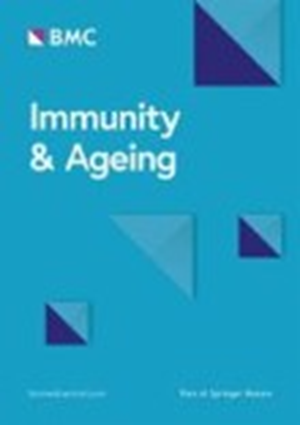An aging-related immune landscape in the hematopoietic immune system
IF 5.2
2区 医学
Q1 GERIATRICS & GERONTOLOGY
引用次数: 0
Abstract
Aging is a holistic change that has a major impact on the immune system, and immunosenescence contributes to the overall progression of aging. The bone marrow is the most important hematopoietic immune organ, while the spleen, as the most important extramedullary hematopoietic immune organ, maintains homeostasis of the human hematopoietic immune system (HIS) in cooperation with the bone marrow. However, the overall changes in the HIS during aging have not been described. Here, we describe a hematopoietic immune map of the spleen and bone marrow of young and old mice using single-cell sequencing and flow cytometry techniques. We observed extensive, complex changes in the HIS during aging. Compared with young mice, the immune cells of aged mice showed a marked tendency toward myeloid differentiation, with the neutrophil population accounting for a significant proportion of this response. In this change, hypoxia-inducible factor 1-alpha (Hif1α) was significantly overexpressed, and this enhanced the immune efficacy and inflammatory response of neutrophils. Our research revealed that during the aging process, hematopoietic stem cells undergo significant changes in function and composition, and their polymorphism and differentiation abilities are downregulated. Moreover, we found that the highly responsive CD62L + HSCs were obviously downregulated in aging, suggesting that they may play an important role in the aging process. Overall, aging extensively alters the cellular composition and function of the HIS. These findings could potentially give high-dimensional insights and enable more accurate functional and developmental analyses as well as immune monitoring in HIS aging.造血免疫系统中与衰老相关的免疫景观
衰老是一种整体性变化,对免疫系统有重大影响,而免疫衰老则是衰老整体进展的一个重要因素。骨髓是最重要的造血免疫器官,而脾脏作为最重要的髓外造血免疫器官,与骨髓共同维持人体造血免疫系统(HIS)的平衡。然而,造血免疫系统在衰老过程中的整体变化尚未得到描述。在这里,我们利用单细胞测序和流式细胞仪技术描述了年轻和年老小鼠脾脏和骨髓的造血免疫图谱。我们观察到 HIS 在衰老过程中发生了广泛而复杂的变化。与年轻小鼠相比,衰老小鼠的免疫细胞表现出明显的髓系分化趋势,其中中性粒细胞群体在这一反应中占了很大比例。在这一变化中,缺氧诱导因子1-α(Hif1α)明显过度表达,这增强了中性粒细胞的免疫功效和炎症反应。我们的研究发现,在衰老过程中,造血干细胞的功能和组成会发生重大变化,其多态性和分化能力会被下调。此外,我们发现高反应性的 CD62L + 造血干细胞在衰老过程中明显下调,这表明它们可能在衰老过程中扮演重要角色。总之,衰老会广泛改变 HIS 的细胞组成和功能。这些发现有可能提供高维度的见解,并能对 HIS 的衰老过程进行更准确的功能和发育分析以及免疫监测。
本文章由计算机程序翻译,如有差异,请以英文原文为准。
求助全文
约1分钟内获得全文
求助全文
来源期刊

Immunity & Ageing
GERIATRICS & GERONTOLOGY-IMMUNOLOGY
CiteScore
10.20
自引率
3.80%
发文量
55
期刊介绍:
Immunity & Ageing is a specialist open access journal that was first published in 2004. The journal focuses on the impact of ageing on immune systems, the influence of aged immune systems on organismal well-being and longevity, age-associated diseases with immune etiology, and potential immune interventions to increase health span. All articles published in Immunity & Ageing are indexed in the following databases: Biological Abstracts, BIOSIS, CAS, Citebase, DOAJ, Embase, Google Scholar, Journal Citation Reports/Science Edition, OAIster, PubMed, PubMed Central, Science Citation Index Expanded, SCImago, Scopus, SOCOLAR, and Zetoc.
 求助内容:
求助内容: 应助结果提醒方式:
应助结果提醒方式:


